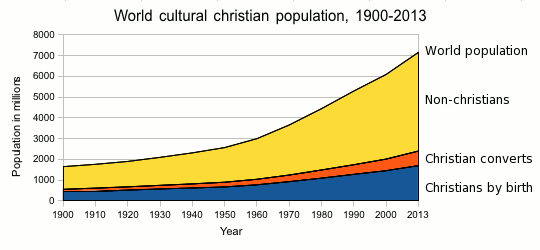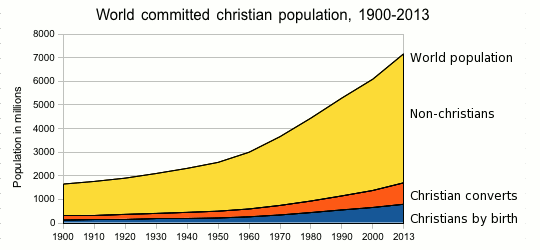This page in brief
How do people get to be christians? Do many convert by their own choice, or do most just get born into christian families or christian countries? And what does this say about whether people have good reasons to be christians?
I couldn’t find good answers to these questions, so I decided to do some research and analyse the data myself. The answers were interesting, and maybe a little surprising – about a third to a half of present day christians are converts.
Sceptics and converts
Critics of christianity sometimes argue that most christians believe without good reason. This argument is partly based on the “fact” that most people in the world follow the religion of the country they were born into. Therefore, the argument goes, if they were born elsewhere they would believe differently, thus demonstrating that most people’s faith is based on geography rather than good reasons, and few people convert because they are convinced of the truth of christianity.
Testing the argument
The argument raises a challenging point, although it seems to fall short as an argument:
- Believing in the religion one was brought up in doesn’t make that religion wrong – or right.
- If a religion grows, as christianity has grown, it must, as a matter of sheer mathematics, start out by making converts. But as it becomes larger, the number of people born into the faith must inevitably increase.
- Christianity is in decline in most of the traditionally christian countries of the west (mainly Europe and North America), but is growing fast in generally non-christian countries in Asia and Africa. This suggests christianity finds it easier to make converts than to retain those born into a christian heritage.
But what are the numbers?
If you can’t find it, do it yourself
I couldn’t find the information I needed online (only one source came close, but as noted below, the information was problematic). So I decided to gather the best information I could find and develop a population model in a spreadsheet. I am not a demographer, but I am familiar with spreadsheet models. A more detailed description of what I did is below.
How many christian converts?
The spreadsheet modelled christian and non-christian populations in the west (Europe and North America) and the rest of the world, and was calibrated to conform to known data. It produced the following results.
Christian culture
Using data on the number of those who self-identified as christians, the model suggested about 30% of christians living today were converts and about 70% were born into nominally christian families or culture.

Christian families
I also wanted to see if the result changed if only those who were “active” christians were considered (approximately identified as those who attended church regularly). On this basis, about half of christians living today were converts and half were born into christian families.
This model and the history of christianity
Christianity began in the Middle East, and grew by making converts. Within a few centuries there were more christians in Europe than anywhere else. By 1900, christianity had become entrenched in christian culture in Europe, but it was beginning to lose numbers. So the graph shows that there were then relatively few converts in Europe and North America, and most christians were born into the faith.
But the twentieth century also saw the beginning of a massive growth in christianity in Africa and Asia (and a change in the style of christianity in South America). So the number of conversions began to rise again. This growth continues to this day, but inevitably will eventually lead to more people being born into christian families, and the number of converts will probably begun to drop as a proportion.
Conclusion
Clearly many christians (about 30-50%, depending on how “christians” are defined) living today are converts from a “non-christian” background. They clearly had some reason to change faiths.

More about the model (for those interested)
Data
It is very hard to find reliable and consistent information about population and religious belief. Here are my sources:
- World population by Pew Forum, Wikipedia, DSS Research, Vaughn’s, Geohive, Worldometers, University of Botswana, ADMC and Facts & Details.
- Christian numbers by Questia, Pew Forum, Douglas Jacobsen and Why Church
- Birth, death, conversion and deconversion rates, by World Bank, The Guardian, Pew Forum, Tom Smith and Wikipedia.
- Church attendance by Church Leaders, Hadaway, Marler & Chaves, Adherents.comClaude Fischer, PBS, Wikipedia, Nationmaster andFranck & Iannaccone.
The model
1. The model uses 10-year periods from 1900 to 2013. Calculations were done for the west (Europe and North America) and the rest of the world, and then summed to give the global figures.
2. In each period, the data for the previous period was used to calculate the numbers of births and deaths (for the whole community and just for christians), plus conversions to christianity and ‘deconversions’ from christianity. These allowed the values for total population, christian converts, christians by birth and non-christians tro be calculated for the end of the decade.
3. The birth and death rates were adjusted as necessary to allow the known populations to be reproduced by the model. This then determined the births and deaths within the christian community.
4. Then the estimated conversion and deconversion rates were adjusted to accurately reproduce the estimated christian populations.
5. The percentage of the christian community in the ‘converts’ category could then be calculated from the final populations in 2013.
6. All this was done for the referenced values for the overall christian populations – this measures what may be termed christian culture, for it is based on nominal beliefs. To determine the results for what may be termed ‘committed’ christian belief, the figures for the ‘christian populations were amended to reflect church attendance. (These figures were generally lower, e.g. in North America, ‘christians’ comprise about 80% of the population, but church attendance is about 40%.) A second spreadsheet then performed the same calculation to give the second figure.
Assessment
- The only data that could not be obtained and tested by the model was the initial percentages of christian converts in 1900. But the model was run for a range of likely values, and the model was not too sensitive to the starting assumptions – ranges were 29-36% of nominal christians but 46-53% of church attenders.
- The results make sense. While christianity in the west is fairly static, it is growing fast in the rest of the world, where about two thirds of the world’s christians now live. I would therefore expect there would be a relatively large number of converts from the rest of the world.
- The only other estimate I have seen (by the World Christian Database) gives a lower percentage of converts (about 10%) but (i) the result doesn’t actually measure converts, but the residual of conversions minus deconversions, (ii) some of the WCD figures were inconsistent, even within themselves, and (iii) there was no way to obtain the populations shown by the data sources using the WCD figures.
- I am therefore happy that the model makes a good attempt to reproduce established data.
.
Feedback on this page
Comment on this topic or leave a note on the Guest book to let me know you’ve visited.




